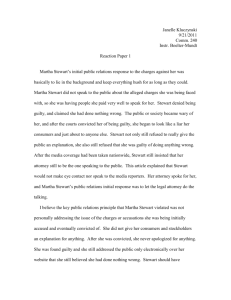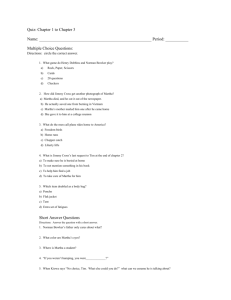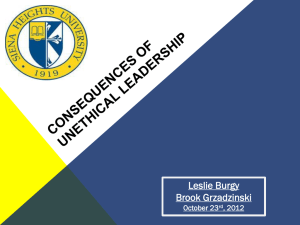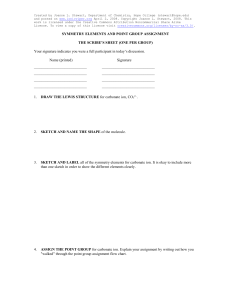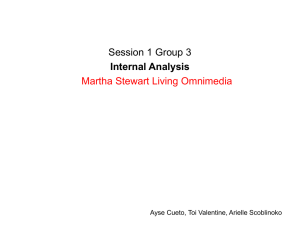Martha Stewart's Insider Trading Scandal
advertisement
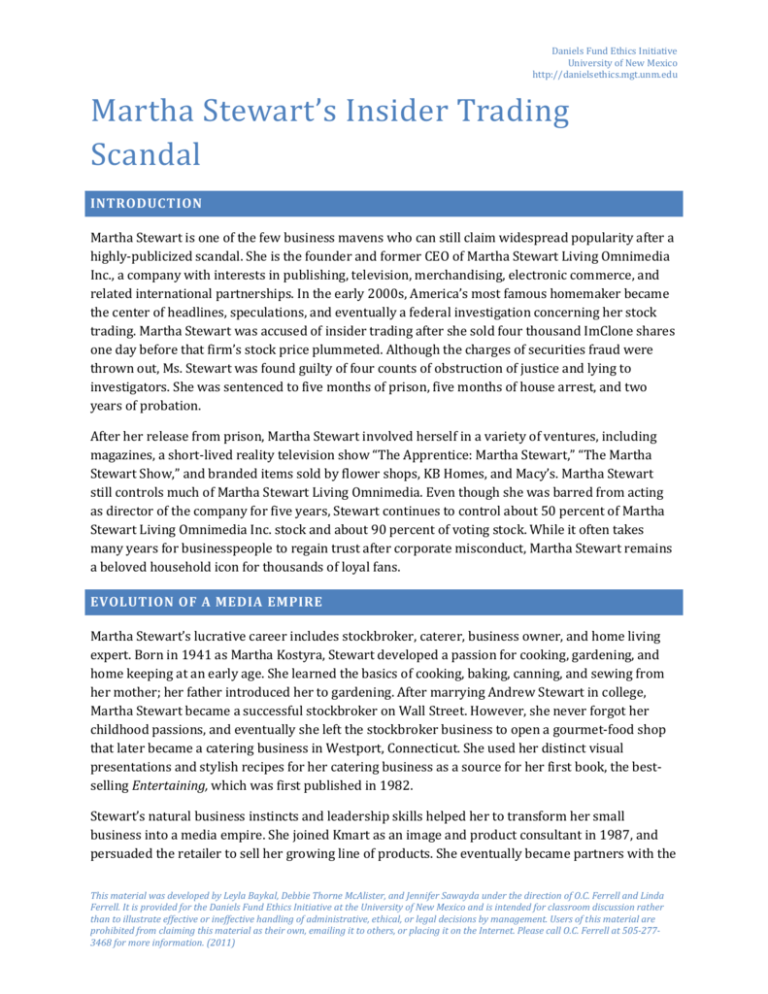
Daniels Fund Ethics Initiative University of New Mexico http://danielsethics.mgt.unm.edu Martha Stewart’s Insider Trading Scandal INTRODUCTION Martha Stewart is one of the few business mavens who can still claim widespread popularity after a highly-publicized scandal. She is the founder and former CEO of Martha Stewart Living Omnimedia Inc., a company with interests in publishing, television, merchandising, electronic commerce, and related international partnerships. In the early 2000s, America’s most famous homemaker became the center of headlines, speculations, and eventually a federal investigation concerning her stock trading. Martha Stewart was accused of insider trading after she sold four thousand ImClone shares one day before that firm’s stock price plummeted. Although the charges of securities fraud were thrown out, Ms. Stewart was found guilty of four counts of obstruction of justice and lying to investigators. She was sentenced to five months of prison, five months of house arrest, and two years of probation. After her release from prison, Martha Stewart involved herself in a variety of ventures, including magazines, a short-lived reality television show “The Apprentice: Martha Stewart,” “The Martha Stewart Show,” and branded items sold by flower shops, KB Homes, and Macy’s. Martha Stewart still controls much of Martha Stewart Living Omnimedia. Even though she was barred from acting as director of the company for five years, Stewart continues to control about 50 percent of Martha Stewart Living Omnimedia Inc. stock and about 90 percent of voting stock. While it often takes many years for businesspeople to regain trust after corporate misconduct, Martha Stewart remains a beloved household icon for thousands of loyal fans. EVOLUTION OF A MEDIA EMPIRE Martha Stewart’s lucrative career includes stockbroker, caterer, business owner, and home living expert. Born in 1941 as Martha Kostyra, Stewart developed a passion for cooking, gardening, and home keeping at an early age. She learned the basics of cooking, baking, canning, and sewing from her mother; her father introduced her to gardening. After marrying Andrew Stewart in college, Martha Stewart became a successful stockbroker on Wall Street. However, she never forgot her childhood passions, and eventually she left the stockbroker business to open a gourmet-food shop that later became a catering business in Westport, Connecticut. She used her distinct visual presentations and stylish recipes for her catering business as a source for her first book, the bestselling Entertaining, which was first published in 1982. Stewart’s natural business instincts and leadership skills helped her to transform her small business into a media empire. She joined Kmart as an image and product consultant in 1987, and persuaded the retailer to sell her growing line of products. She eventually became partners with the This material was developed by Leyla Baykal, Debbie Thorne McAlister, and Jennifer Sawayda under the direction of O.C. Ferrell and Linda Ferrell. It is provided for the Daniels Fund Ethics Initiative at the University of New Mexico and is intended for classroom discussion rather than to illustrate effective or ineffective handling of administrative, ethical, or legal decisions by management. Users of this material are prohibited from claiming this material as their own, emailing it to others, or placing it on the Internet. Please call O.C. Ferrell at 505-2773468 for more information. (2011) 2 firm. This partnership helped her gain the capital necessary to break free of Time Warner, publisher of her highly successful Martha Stewart Living magazine. When Stewart and Time Warner disagreed on her intentions to cross-sell and market her publishing, television, merchandising, and Web interests, she used everything she owned to buy back the brand rights of her products and publishing for an estimated $75 million. In 1999 she took her rapidly growing business public. Martha Stewart Living Omnimedia, the company she created, soon owned three magazines, a TV and cable program, thirty-four books, a newspaper column, a radio program, a Web site, and a merchandising line, as well as the Martha by Mail catalog business. Its media properties reached 88 million people a month around the world, allowing them to command top advertising rates. Martha Stewart’s successes soon became widely recognized. Her television show won an Emmy, and Adweek named her “Publishing Executive of the Year” in 1996. She has been named one of “New York’s 100 Most Influential Women in Business,” by Forbes 400, “50 Most Powerful Women” by Fortune, and “America’s 25 Most Influential People” by Time. In 1998 she was the recipient of an Edison Achievement Award from the American Marketing Association. Stewart has also earned many other national awards and honors. Martha Stewart Living Omnimedia is clearly a success story that turned a small catering business into a well-known brand and made its founder synonymous with stylish living and an advocate of good taste. Even those who have ridiculed Stewart’s perfect-housewife image acknowledge her confidence and business acumen. One author commented, “To the degree that her business partners were prepared to help advance the success of Martha Stewart, she was prepared to work with them. To the degree that they got in her way, she was willing to roll right over them.” Another admired her hard-working nature by saying, “Anyone who spends more than a few minutes with America’s most famous homemaker learns that she is one heck of a juggler.” THE INSIDER TRADING SCANDAL The scandal that would threaten Stewart’s career stemmed from her association with Imclone System, a biopharmaceutical company in which Stewart owned stock. Stewart sold 4,000 shares of ImClone stock on December 27, one day before the Food and Drug Administration refused to review ImClone System’s cancer drug Erbitux. The company’s stock tumbled following the FDA’s announcement. A similar situation occurred with a number of other ImClone insiders, including the company’s counsel John Landes, who dumped $2.5 million worth of the company’s stock on December 6; Ronald Martell, ImClone’s vice president of marketing, who sold $2.1 million worth of company stock on December 11; and four other company executives who cashed in shares between December 12 and December 21. The event was too coincidental to be ignored. DEVELOPMENTS IN THE SCANDAL Later investigations revealed that after learning the FDA would refuse to review Erbitux, Sam Waksal, the CEO of ImClone and a close friend of Stewart, instructed his broker Peter Bacanovic— who was also Stewart’s broker—to transfer $4.9 million in stock to the account of his daughter Aliza Waksal. His daughter also requested that Bacanovic sell $2.5 million of her own ImClone 3 stock. Sam Waksal then tried to sell the shares he had transferred to his daughter, but was blocked by brokerage firm Merrill Lynch. Phone records indicate that Bacanovic called Martha Stewart’s office on December 27 shortly after Waksal’s daughter dumped her shares. Stewart’s stock was sold ten minutes later. Sam Waksal was arrested on June 12 on charges of insider trading, obstruction of justice, and bank fraud in addition to previously filed securities fraud and perjury charges. Although he pleaded innocent for nine months, Sam Waksal eventually pleaded guilty to insider trading and another six out of thirteen charges. Waksal, who was sentenced to seven years in prison but was released after five, said in his plea that, “I am aware that my conduct, while I was in possession of material nonpublic information, was wrong, I’ve made some terrible mistakes and I deeply regret what has happened.” Martha Stewart denied that she engaged in any improper trading when she sold her shares of ImClone stock. On December 27, Stewart says she was flying in her private jet to Mexico for a vacation with two friends. En route, she called her office to check her messages, which included one from her broker Peter Bacanovic, with news that her ImClone stock had dropped below $60/share. Stewart claims she had previously issued a “stop-loss” order to sell the stock if it fell below $60/share. Stewart called Bacanovic and asked him to sell her 3,928 shares; she also called her friend Sam Waksal, but could not reach him. Stewart’s assistant left a message for Sam Waksal saying, “Something’s going on with ImClone, and she wants to know what it is. She’s staying at Los Ventanos.” Waksal did not call her back. At about the time Stewart made her sale, she was on her way to Mexico with friend Mariana Pasternak. However, Stewart’s explanation that she unloaded her stock because of a prearranged sell order collapsed when Douglas Faneuil, the broker’s assistant who handled the sale of the ImClone stock for Stewart, told Merrill Lynch lawyers that his boss, Peter Bacanovic, had pressured him to lie about a stop-loss order. Although he initially backed Stewart’s story, he later told prosecutors that Bacanovic prompted him to advise Stewart that Waksal family members were dumping their stock and that she should consider doing the same. During interviews with law enforcement officials, Faneuil said, “I did not truthfully reveal everything I knew about the actions of my immediate supervisor and the true reason for the sales.” He reportedly received money or other valuables for hiding his knowledge from investigators. Faneuil pleaded guilty to a misdemeanor charge on October 2. Martha Stewart resigned from her board membership of the New York Stock Exchange the next day. Faneuil was later fined $2,000 but did not receive jail time. Merrill Lynch fired Faneuil after he pleaded guilty; Bacanovic was also fired for declining to cooperate with investigators looking into trading activity of ImClone Systems Inc. shares. THE PROBE In August 2002, investigators requested Stewart’s phone and e-mail records related to ImClone stock trade and her Merrill Lynch account as well as those of her business manager. Stewart and Bacanovic could not provide proof that a stop-loss order existed. Congressional investigators for the U.S. House of Representatives’ Energy and Commerce Committee could not find any credible record of such an order between Stewart and her broker. However, portions of the documents 4 presented to the committee were unreadable because they were blacked out. Stewart’s lawyers later agreed to return to Capitol Hill with unedited documents. The committee did not call Martha Stewart to testify in front as her lawyers had made it clear that she would invoke her Fifth Amendment right to remain silent. Investigators, who had been negotiating unsuccessfully with Stewart’s lawyers to arrange for her voluntary testimony, came to believe that Stewart has been “stonewalling” and would not cooperate. Many wondered, “If Ms. Stewart has been straight about her story, then why wouldn’t she tell it under oath?” Throughout the period after the scandal broke out, however, Stewart and her spokespeople declined to comment or could not be reached. The House Energy and Commerce Committee ultimately handed the Martha Stewart/ImClone investigation over to the U.S. Justice Department, with a strong suggestion to investigate whether Stewart had lied to the committee. Additionally, the SEC indicated that it was ready to file civil securities fraud charges against Stewart for her alleged role in an insider trading scandal and her public statement about the stop-loss arrangement with her broker. Federal prosecutors widened their investigation to include whether Stewart’s public statements about why she sold ImClone shares were intended to increase the price of her own company’s stock and constituted securities fraud. Federal law bars officers of public corporations from knowingly making false statements that are material in effect—meaning they have the potential to shape a reasonable investor’s decision to buy or sell stock in a particular company. If prosecutors would be able to prove that Stewart made a deceptive statement to repair her credibility, it could be actionable. Ironically, Martha Stewart could have sold her ImClone stock on December 31 instead of December 27 and collected $180,000 in profit without raising any concerns. That’s just $48,000 less than what she gained through the earlier sale. Although Stewart denied any wrongdoing, the scandal sliced more than 70 percent off the stock price of Omnimedia and, according to one estimate, washed away more than a quarter of her net worth. Before the scandal Stewart had an estimated net worth of $650 million. CONVICTION AND JAIL TIME Perhaps one of the more damaging testimonies which sealed Martha Stewart’s fate was the testimony of her then friend Mariana Pasternak. On the witness stand, Pasternak revealed that she believed Stewart had made a statement indicating her involvement with insider trading. According to Pasternak, Stewart had said, “Isn’t it nice to have brokers who will tell you these things” at around the time the alleged misconduct took place. With testimonies such as these and the failure to provide proof that a stop-call order existed, the situation looked bad for Stewart. The jury found Martha Stewart guilty on four counts of obstructing justice and lying to investigators. On June 17, 2004, a judge sentenced Martha Stewart to five months in prison and two years of supervised release, along with fining her $30,000. Stewart went to prison proclaiming her innocence, which she still maintains to this day. Although Stewart had appealed her sentence and could have waited until her appeal before serving time, she opted to “put the ordeal behind her.” In 2006 the U.S. Court of Appeals for the Second Circuit in New York upheld Stewart’s conviction. 5 When the scandal first became public, Martha Stewart began a campaign to detach herself from the events. However, she could not escape questions about the insider trading scandal. Even in a regular weekly cooking segment on CBS’s “The Early Show,” host Jane Clayson attempted to ask about the scandal, but Stewart responded: “I want to focus on my salad…” Her refusal to testify made many wonder whether she really was innocent. On CBS News, for example, Steven Fink, president of Lexicon Communications, questioned Stewart’s choice of avoiding to face the questions: “Someone as culturally prominent as Stewart would be expected to address the public and she has not really done that, resulting, rightly or wrongly, in the perception that she has something to hide.” When she was sent to prison, however, Martha Stewart seemed to do an about face. Though she accepted her sentence, she continued to maintain her innocence, even invoking the name of former South African president Nelson Mandela as an example of the “many good people who have gone to prison.” During her jail time, she kept in contact with her fans by posting letters on her website describing her life in prison. By going to prison early, one marketing expert believes she went “from villain to victim.” The result was that although Martha Stewart’s image was tainted, she still maintained her popularity and many of her fans’ loyalty. Around the time of her release, shares at Martha Stewart Living Omnimedia were nearly four times higher than they were when she was sentenced. MARTHA STEWART TODAY Today Martha Stewart Living Omnimedia is making a comeback through a number of different ventures. Partnerships include E. & J. Gallo (Martha Stewart Vintage wines), KB Home (Marthabranded Homes), and Macy’s (Martha kitchen, dining, and bedding collections). Martha Stewart herself hosted two shows, her short-lived “The Apprentice: Martha Stewart” and “The Martha Stewart Show,” currently aired on the Hallmark channel. She also published a book, Dinner at Home, which became a bestseller. Yet although Martha Stewart appears to be rebounding, Martha Stewart Living Omnimedia has suffered. The scandal occurred at an unfortunate time for Martha Stewart Living Omnimedia. The company’s publishing arm was in its mature stage, its television show was suffering declining ratings, and the Internet operation was taking heavy losses. At her conviction Martha Stewart’s brand equity for her personal brand was ranked worse than Enron’s. Although it has increased once more, it is not as high as it was before her conviction. Martha Stewart Living Omnimedia lost $16 million in 2008 when the recession hit and experienced an estimated loss of $10 million in 2010. TV ratings for “The Martha Stewart Show” fell 70 percent in 2010 compared to the year before. A major problem that Martha Stewart Living Omnimedia encountered with Stewart’s conviction and incarceration was its strong association with Stewart. Market analysts believe that the company depended too heavily on the name and image of its celebrated founder. Before the scandal, Stewart personified a brand that associated with her credibility and honesty—traits the public and investigators called into question with her conviction. In this case, the strength of the brand also becomes its weakness, as it is hard to tell where the person ends and the brand begins. Market analysts agree that Stewart needs to take steps to ensure that the brand can go beyond the 6 person. Stewart believes that her business can live on without her because it is now a combination of her artistic philosophy, spirit, and creativity of others. Marketing experts are not so sure. While some feel that the brand can stand on its own, others believe it is still too hard to separate Martha Stewart the person from Martha Stewart the brand. PERSPECTIVES ON THE MARTHA STEWART SCANDAL To this day the Martha Stewart scandal continues to yield different opinions. Supporters of Stewart accused the prosecution of unfairly targeting Stewart because of her popularity. Stewart avoided a $51,000 loss by selling her ImClone shares. Scandals that were occurring around the same time period resulted in much greater losses. For example, Mark Swartz and Dennis Kozlowski were convicted of cheating Tyco out of $600 million, while misconduct at Worldcom and Enron cost investors billions and lost thousands of employees their jobs. It should be noted, however, that many of these men are serving years of prison time, whereas Stewart received five months. Additionally, prosecutors and lawmakers stated their hope that Stewart’s conviction would act as a signal that corporate misconduct would not be tolerated no matter who the perpetrator is. Unfortunately, Martha Stewart’s insider trading scandal pales in comparison to the more recent scandals of companies like Lehman Brothers and Countrywide and individuals like Bernie Madoff’s, who is guilty of a $65 billion Ponzi scheme. Insider trading investigations also rocked the hedge fund industry. In 2009 New York hedge fund billionaire Raj Rajaratnam of Galleon Group was indicted in a $21 million insider trading case. Galleon Group hedge fund trader Danielle Chiesi later pleaded guilty to leaking information on stocks including those from IBM and AMD. Ironically, in one wiretapped exchange Chiesi even compared her situation to Martha Stewart’s. Rajaratnam was later found guilty of 14 counts of securities fraud and conspiracy. Clearly, instances of insider trading have not died down since the Martha Stewart scandal. However, Stewart’s conviction did demonstrate that high-profile individuals would not be immune from the penalties of misconduct. Even successful CEOs of Fortune 500 companies are being forced to account for questionable behavior, as evidenced by Mark Hurd’s resignation from Hewlett-Packard after an internal probe indicated sexual harassment. Lawmakers are taking a strict stance against corporate malfeasance, and corporations are in turn beginning to hold management to higher ethical standards. One can hope that Martha Stewart’s conviction and the more recent conviction of high-profile individuals like Raj Rajaratnam of Galleon Group will reduce future instances of such misconduct. QUESTIONS 1. What role has Martha Stewart’s image played in the insider trading scandal? 2. Will Martha Stewart Living Omnimedia survive if Martha Stewart were to leave the company? In order to survive, what changes will need to be made at the company? 3. How has Martha Stewart’s conviction impacted the business environment today? 7 Sources: Christopher M. Byron, Martha Inc.: The Incredible Story of Martha Stewart Living Omnimedia (New York: John Wiley & Sons, Inc., 2002). Diane Brady, “Martha Inc. Inside the Growing Empire of America’s Lifestyle Queen,” Business Week, Jan. 17, 2000. Julie Creswell, “Will Martha Walk?” Fortune, Nov. 25, 2002, 121–124. Mike Duff, “Martha Scandal Raises Questions, What’s in Store for Kmart?” DSN Retailing Today, Jul. 8, 2002, 1. “Feds Tighten Noose on Martha,” CNN/Money, Feb. 6, 2003, http://money.cnn.com/2003/02/06/news/companies/martha/index.htm (accessed June 17, 2011). Charles Gasparino and Kara Scannell, “Probe of Martha Stewart’s Sale of Stock Enters Its Final Phase,” Wall Street Journal, January24, 2003, C7. Dan Collins, “ImClone Founder To Pay The Price,” CBS News, February 11, 2009, www.cbsnews.com/stories/2002/08/12/national/main518354.shtml (accessed January 18, 2011). “ImClone Probe Costly for Martha Stewart,” MSNBC, Jan. 27, 2003, http://stacks.msnbc.com/news/864675.asp. Charles M. Madigan, “Woman Behaving Badly,” Across The Board, July/August 2002, 75. Jerry Markon, “Martha Stewart Could Be Charged as ‘Tippee,’” Wall Street Journal, Oct. 3, 2002, C1, C9. “Martha’s Mouthpiece: We’ll Deliver,” CBS News, August 20, 2002, www.cbsnews.com/stories/2002/08/20/national/main519320.shtml (accessed July 18, 2011). Matthew Rose, “Martha Stewart Firm Has Loss As ImClone Probes Take Toll,” Wall Street Journal, March 4, 2003, http://online.wsj.com/article/0,,SB1046721988332486840,00.html (accessed June 18, 2011)/ Amy Merrick, “Can Martha Deliver Merry?” Wall Street Journal, October 8, 2002, B1, B3. Keith Naughton, “Martha’s Tabloid Dish,” Newsweek, June 24, 2002, 36 Keith Naughton and Mark Hosenball, “Setting the Table,” Newsweek, September 23, 2002, 7. Dan Collins, “New Witness in Martha Probe,” CBSNews, August 9, 2002, www.cbsnews.com/stories/2002/08/12/national/main518448.shtml (accessed June 17, 2011). Marc Peyser, “The Insiders,” Newsweek, July 1, 2002, 38–53 Thomas A. Stewart, “Martha Stewart’s Recipe for Disaster,” Business2.com, July 3, 2002. Jeffrey Toobin, “Lunch at Martha’s,” The New Yorker, February 3, 2003, 38–44. Thor Valdmanis, “Martha Stewart Leaves NYSE Post,” USA Today, October 4, 2002, 3B. “Martha Stewart Living Omnimedia, Inc. Company Profile,” Yahoo! Finance, http://biz.yahoo.com/ic/53/53053.html (accessed January 20, 2011). Megan L. Thomas, “Martha Stewart Omnimedia is Omnipresent,” MSNBC, August 6, 2010, http://www.msnbc.msn.com/id/38585072/ns/business-us_business (accessed January 20, 2011). “Stewart sentenced to five months in prison,” The Sydney Morning Herald, July 17, 2004, http://www.smh.com.au/articles/2004/07/17/1089694573700.html (accessed January 20, 2011). Krysten Crawford, “Martha, out and about,” CNNMoney, March 4, 2005, http://money.cnn.com/2005/03/03/news/newsmakers/martha_walkup/index.htm (accessed January 20, 2011). “Stewart convicted on all charges,” CNNMoney, March 10, 2004, http://money.cnn.com/2004/03/05/news/companies/martha_verdict/ (accessed January 20, 2011). Lauren Silva Laughlin, “What Martha Stewart should learn from Hugh Hefner,” Fortune, January 12, 2011, http://finance.fortune.cnn.com/2011/01/12/what-martha-stewart-should-learn-from-hugh-hefner/ (accessed January 20, 2011). David Carr, “Martha Stewart, Unchained,” The New York Times, August 29, 2005, http://www.nytimes.com/2005/08/29/business/media/29martha.html?_r=1&ref=marthastewartlivingomnimediainc (accessed January 20, 2011). Melly Alazraki, “ImClone's Sam Waksal: Out of Jail and Doing Biotech Deals Again,” Daily Finance, December 26, 2010, http://www.dailyfinance.com/story/company-news/imclones-sam-waksal-doing-biotech-deals-again/19690303/ (accessed January 20, 2011). Oren Yaniv, “Witness in Stewart Case Gets A $2,000 Fine On Guilty Plea,” The New York Times, July 24, 2004, http://www.nytimes.com/2004/07/24/business/witness-in-stewart-case-gets-a-2000-fine-on-guilty-plea.html?ref=douglasfaneuil (accessed January 20, 2011). Lee Ferran, “Martha Stewart’s Former Friend Wanted Apology,” ABC Good Morning America, March 16, 2010, http://abcnews.go.com/GMA/martha-stewarts-friend-wanted-apology/story?id=10113505 (accessed January 20, 2011). “Martha Stewart’s conviction upheld,” CNNMoney, June 6, 2006, http://money.cnn.com/2006/01/06/news/newsmakers/martha/index.htm (accessed January 20, 2010). Alex Weprin, “ ‘The Martha Stewart Show’ Leaving Syndication for Cable,” Broadcasting & Cable, January 26, 2010, http://www.broadcastingcable.com/article/445917-_The_Martha_Stewart_Show_Leaving_Syndication_For_Cable.php (accessed January 20, 2011). Megan L. Thomas, “Martha Stewart Looks to Complete Comeback,” ABC News/Nightline, November 18, 2009, http://abcnews.go.com/Nightline/martha-stewart-dishes-empire-prison-rachel-ray-exclusive/story?id=9106551&page=1 (accessed January 20, 2011). Chad Bray, “Broad Insider Probe Yields More Charges,” The Wall Street Journal, January 11, 2011, C3. Susan Pulliam and Chad Bray, “Key Plotter Pleads Guilty in Galleon,” The Wall Street Journal, January 20, 2011, A1-A2. “Raj Rajaratnam Indicted for Insider Trading,” ABC News, http://abcnews.go.com/Blotter/raj-rajaratnam-indicted-insidertrading/story?id=9346142&page=3 (accessed January 20, 2011). Krysten Crawford, “Martha: I cheated no one,” CNNMoney, July 20, 2004, http://money.cnn.com/2004/07/16/news/newsmakers/martha_sentencing/ (accessed January 20, 2011). Connie Guglielmo, Ian King and Aaron Ricadela, “HP Chief Executive Hurd Resigns After Sexual-Harassment Probe,” Businessweek, August 7, 2010, http://www.businessweek.com/news/2010-08-07/hp-chief-executive-hurd-resigns-after-sexual-harassment-probe.html (accessed January 20, 2011). Rolfe Winkler, “Martha Struggles to Craft Profits,” The Wall Street Journal, December 24, 2010, C8.

